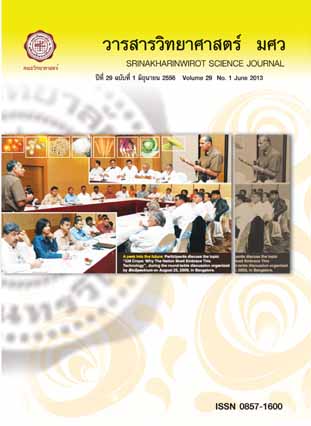กิจกรรมต้านอนุมูลอิสระ สารประกอบฟีนอลิกทั้งหมดและปริมาณกรดแกมมาอะมิโนบิวทิริกในสารสกัดจากข้าวกล้องงอกและข้าวฮางงอกของไทย Antioxidant Activities, Total Phenolic Compounds and γ- Aminobutyric Acid Contents of Extracts Derived from Thai Pre-Germinated Brown
Keywords:
ข้าวกล้องงอก ข้าวฮางงอก ผลได้จากการสกัด กิจกรรมต้านอนุมูลอิสระ สารประกอบฟีนอลิกทั้งหมด กรดแกมมาอะมิโนบิวทิริก pre-germinated brown rice, pre-germinated rough rice, yield, antioxidant activity, total phenolic compounds, γ-aminobutyric acidAbstract
วิธีดั้งเดิมของไทยในการแปรรูปข้าวกล้องให้เป็นข้าวกล้องงอกและแปรรูปข้าวเปลือกให้เป็นข้าวฮางงอกเป็นวิธีที่ช่วยในการเพิ่มคุณค่าทางโภชนาการ, ปรับปรุงเนื้อสัมผัสและเพิ่มปริมาณสารออกฤทธิ์ทางชีวภาพของข้าวในงานวิจัยนี้ ข้าวไทย 4 พันธุ์ ได้แก่ ข้าวเหนียว, ข้าวหอมมะลิ,ข้าวเหนียวดำและข้าวหอมแดง ได้ถูกนำมาแปรรูปให้เป็นข้าวกล้องงอกและข้าวฮางงอกจากนั้นจึงนำไปสกัดด้วยน้ำและนำไปวัดระดับของกิจกรรมต้านอนุมูลอิสระสารประกอบฟีนอลิกทั้งหมดและปริมาณกรดแกมมาอะมิโนบิวทิริก (สารกาบา)ซึ่งผลการทดลองแสดงให้เห็นว่าข้าวกล้องงอกและข้าวฮางงอกของทุกพันธุ์ข้าว ยกเว้นข้าวหอมแดงมีเปอร์เซ็นต์ผลได้ของการสกัดสูงกว่าข้าวที่ไม่ได้รับการกระตุ้นให้เกิดการงอกโดยเฉพาะอย่างยิ่งสารสกัดจากข้าวฮางงอกของข้าวเหนียวดำถูกพบว่ามีผลได้ของการสกัดคือ 9.39% นอกจากนี้สารสกัดจากข้าวฮางงอกของข้าวเหนียวและข้าวหอมมะลิมีกิจกรรมต้านอนุมูลอิสระสูงกว่าข้าวกล้องงอกและข้าวกล้องของพันธุ์ข้าวดังกล่าวอย่างมีนัยสำคัญทางสถิติ ซึ่งการทดสอบกิจกรรมในการดักจับอนุมูลอิสระ DPPHแสดงให้เห็นว่าข้าวฮางงอกของข้าวหอมมะลิมีกิจกรรมต้านอนุมูลอิสระสูงที่สุด คือ 1.66 ± 0.30 มิลลิกรัมเทียบเท่า BHA ต่อกรัมน้ำหนักแห้งของข้าว นอกจากนี้ข้าวฮางงอกของข้าวเหนียวดำถูกพบว่ามีสารประกอบฟีนอลิกทั้งหมดสูงที่สุด คือ 1.42± 1.10 มิลลิกรัมเทียบเท่า gallic acid ต่อกรัมน้ำหนักแห้งของข้าว ถึงแม้ว่าค่าดังกล่าวจะไม่แตกต่างอย่างมีนัยสำคัญทางสถิติกับค่าที่พบในข้าวอื่นๆอาจเนื่องมาจากผลที่ได้จากการทดลองมีความแปรปรวนสูง การแปรรูปข้าวเหนียว, ข้าวหอมมะลิและข้าวเหนียวดำให้อยู่ในรูปข้าวฮางงอกนั้นถูกพบว่าสามารถเพิ่มปริมาณสารกาบาในข้าวได้อย่างมีนัยสำคัญทางสถิติโดยเฉพาะอย่างยิ่งข้าวฮางงอกของข้าวเหนียวดำและข้าวหอมมะลินั้นถูกพบว่ามีการเพิ่มขึ้นของสารกาบาสูงขึ้น4 ถึง 7 เท่า เมื่อเทียบกับข้าวกล้องของพันธุ์ข้าวดังกล่าว ถึงแม้ว่าข้าวกล้องของข้าวหอมแดงจะถูกพบว่ามีปริมาณสารกาบาสูงที่สุด คือ116.07 ± 0.91 ไมโครกรัมต่อกรัมน้ำหนักแห้งของข้าว แต่ข้าวกล้องงอกและข้าวฮางงอกของข้าวชนิดนี้ถูกพบว่ามีปริมาณสารกาบาต่ำกว่ามากการวิเคราะห์ด้วย Two-way ANOVA พบว่าพันธุ์ข้าวและวิธีการแปรรูปมีความสัมพันธ์กันและส่งผลต่อกิจกรรมต้านอนุมูลอิสระ(P=0.002) และปริมาณสารกาบา (P<0.001) อย่างมีนัยสำคัญทางสถิติ ดังนั้นชนิดของพันธุ์ข้าวและวิธีการแปรรูปอาจจะมีบทบาทสำคัญต่อปริมาณสารออกฤทธิ์ทางชีวภาพบางชนิดในข้าว ข้อมูลที่ได้จากการวิจัยนี้อาจจะเป็นประโยชน์ต่อการพัฒนาผลิตภัณฑ์จากข้าวกล้องงอกและข้าวฮางงอกเพื่อนำไปใช้ในเชิงโภชนาการการบำบัดรักษาและเครื่องสำอางในอนาคตThai traditional methodsfor processing brown rice (BR) into pre-germinated brown rice (GBR) and roughrice into pre-germinated rough rice (GRR) have been used to increase rice’snutritional values, improve textures and increase bioactive compounds. In thisstudy, four Thai rice cultivars, including waxy rice, jasmine rice, purple waxyrice and red hawn rice, were processed into GBR and GRR, extracted usingdistilled water and determined for levels of antioxidant activities, totalphenolic compounds and γaminobutyric acid (GABA) contents. The results showed that GBR and GRR of allrice cultivars, except red hawn rice, have percent yield of extracts higherthan those without pre-germination. Especially, the extract of GRR of purplewaxy rice was found to have the highest yield at 9.39%. Moreover,the extracts of waxy rice and jasmine rice in the form of GRR were found tohave levels of antioxidant activities significantly higher than their GBR and BR. Indeed,DPPH scavenging assay showed that GRR of jasmine rice have the maximumantioxidant activities at 1.66 ± 0.30mg BHA equivalents/g dry weight of rice. In addition, GRR of purple waxy ricewas found to have the highest total phenolic compounds at 1.42± 1.10 mg gallic acid equivalents/g dry weight of rice,although not significantly different from the others perhaps due to highvariation of data. Moreover, GRR processing method was also shown tosignificantly increase the levels of GABA in waxy rice, jasmine rice and purplewaxy rice. In particular, GRR of purple waxy rice and jasmine rice were foundto have 4-7 fold increase of GABA when compared to their BR. Although BRof red hawn rice was found to have the highest level of GABA at 116.07± 0.91 µg/g dry weight of rice, its GBR and GRR were foundto have much lower GABA contents. Two-way ANOVA analysis suggested that therewere significant interactions between rice cultivars and processing methods onantioxidant activities (P=0.002) and GABA contents(P<0.001). This may suggest that types of ricecultivars and processing methods may play important roles on some rice’s levelsof bioactive compounds. The data from this study could be beneficial for thefuture development of pre-germinated brown rice and pre-germinated rough riceproducts for nutritional, therapeutic and cosmetic purposes.Downloads
Download data is not yet available.
Downloads
Published
2013-06-30
How to Cite
รัตนเสนา ป., & บุษหมั่น ป. (2013). กิจกรรมต้านอนุมูลอิสระ สารประกอบฟีนอลิกทั้งหมดและปริมาณกรดแกมมาอะมิโนบิวทิริกในสารสกัดจากข้าวกล้องงอกและข้าวฮางงอกของไทย Antioxidant Activities, Total Phenolic Compounds and γ- Aminobutyric Acid Contents of Extracts Derived from Thai Pre-Germinated Brown. Science Essence Journal, 29(1). Retrieved from https://ejournals.swu.ac.th/index.php/sej/article/view/3247
Issue
Section
Research Article








